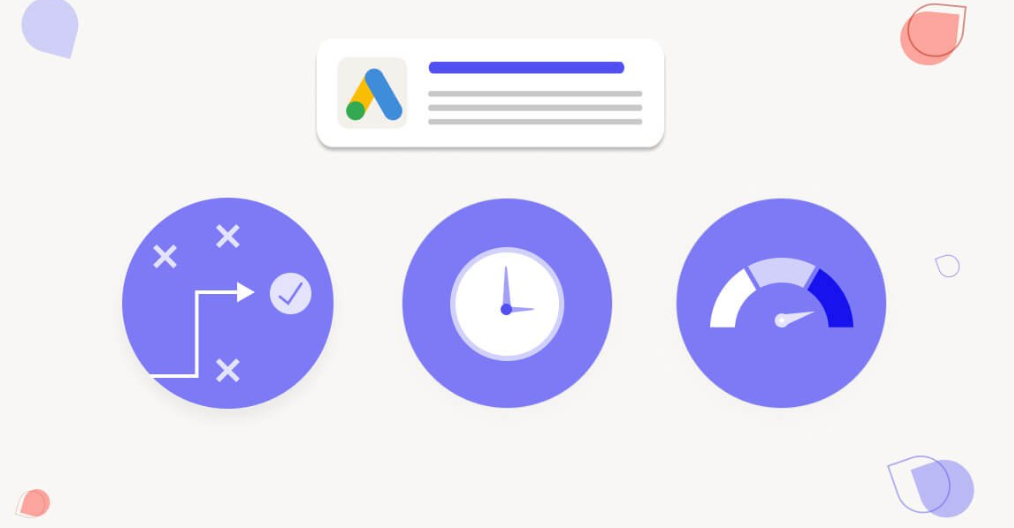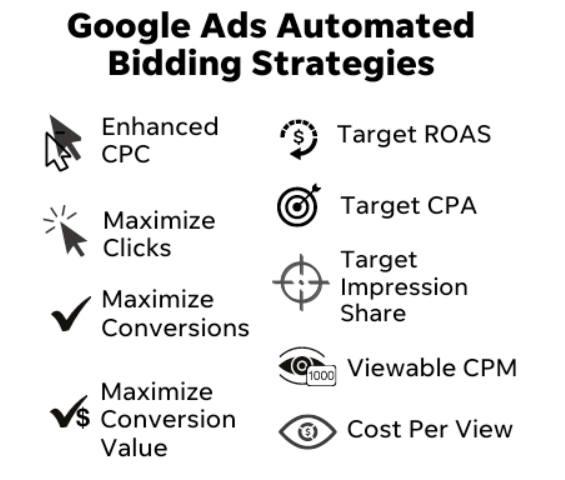In manual bidding you tell Google how much you’re willing to pay for each click, automated bidding adjusts bids on your behalf to optimize for your goals. Automated bids are tweaked by Google in response to their performance and other insights, which in theory should make them more efficient.
Within the automated bidding category is the further optimized Smart Bidding option. This is an automated bid setting that optimizes specifically for conversions or conversion value — that means it’s more specialized and better-suited to some goals, but you shouldn’t use Smart Bidding for every single goal due to its hyper-focus on conversions.
Otherwise, the automated bidding objectives and strategies surrounding them include:
- Maximize clicks
- Maximize conversions
- Maximize conversion value
- Target CPA (cost-per-action)
- Target ROAS (return on ad spend)
- Target impression share
So, while there is a level of intuitiveness to these strategies, the minutiae of how best to use them and the details of their overlap can be missed. With that in mind…
Why should you use automated bidding for each of these strategies?
Just like with all automated tools, the unifying “why” is that it relieves you of the resources you’d need to input to get comparable results if you were doing this manually — namely time and human energy and, through extension, money.
Essentially, this automated bidding is quicker and easier, allowing you to be more efficient with your time and energy that can now be used elsewhere.
Along with that, in theory, it should help you maximize results in a way that manual bidding might not allow you to simply because of the limitations of human judgment and insights. So, instead, Google sets bid amounts automatically based on their insights, making it so you don’t have to constantly update bids manually for keywords or ad groups, something which can be quite tedious, not to mention fallible given humans’ lesser precision.
Bids with automated bidding are unique to each auction and learn over time what the optimal bid should be using past data. The longer your history with automated bidding, the more information automated bidding has to draw from, and the more optimal your bids can be.
Strategies and how to best approach each
Image source: wordstream.com
There’s quite a few here, let’s jump right in:
Maximize clicks
As the name makes pretty clear, this strategy is as straightforward as it sounds: get as many clicks as possible.
Here, there aren’t limitations on how much to bid, although you can set a cap on your bids.
Because the aim here is simply getting a boatload of clicks, there aren’t any guardrails for the quality of clicks; however you may define that. Due to this, maximizing clicks is useful for search campaigns to generate new traffic but you should use it sparingly, as overreliance won’t be a very efficient approach — rather, you’ll end up with a bunch of clicks but a relatively low proportion of quality visitors.
Target impression share
The primary purpose here is to generate brand awareness by creating a certain level of visibility. This improves users’ awareness, whether consciously or otherwise, by giving them a baseline level of familiarity with you.
Target impression share then helps reach as many people as possible — it’s especially well-suited for pairing with key search terms related to your brand.
Maximize conversions
Image source: adespresso.com
This considers your campaign budget and then from there is designed to get as many conversions as possible within that constraint.
In some ways, this is similar to maximize clicks except here Google focuses on clicks that they’ve determined are most likely to lead to the user converting, whereas the maximize clicks setting doesn’t make that distinction. (It should be noted that conversion tracking has to be enabled for this to work.)
This is ideal of course, if you want to increase your conversions, but it’s also good if you want many clicks but have a limited budget.
Target CPA
This is an option from within the target conversion bid strategy, within which you can choose target CPA — that’s cost per acquisition — as your strategy. It’s one of the most common strategies, and its appeal makes sense given its focus on how much you’re spending per, well, acquisition.
Here, you’ll designate a target cost per action — say, signup, purchase, etc. — and the automated bidding will make bidding decisions accordingly.
This is good for maximizing conversions while keeping your cost for each one low. In conjunction with that, it helps you avoid getting charged for low-quality clicks that aren’t likely to result in people converting. That being said, you should have a budget of about two times your target cost per acquisition, so keep that in mind when you choose this route.
Maximize conversion value
This is essentially a more advanced version of the maximize conversion strategy. Maximize conversion value doesn’t look at just the number, but the theoretical quality level of a conversion — for example, a conversion where somebody spends $100 should be valued higher than one where someone spends $5. Essentially, quality over quantity — but also quality and as much quantity as possible within that quality.
Conversion tracking also needs to be enabled here, and you’ll need to assign a value to each action as well.
Target ROAS
Image source: adespresso.com
This is its own subset within the maximize conversion value strategy where you can choose to bid based on target ROAS or return on ad spend.
Target ROAS is extremely similar to target CPA, as the names suggest. Here, Google looks at your old performance data to project conversion and conversion value performance, then adjusts bids accordingly to maximize conversion value within your set ROAS goal. While individual conversions may have a higher or lower return on ad spend than your target, over time and as the sample size increases, Google will balance it out to hit your target ROAS.
Once again, you’ll need conversion tracking in place for this to work. We also recommend starting with a lower target ROAS — ideally slightly lower than your recent performances — and then increasing your target over time to improve your profitability.
Choosing your bidding strategy and best practices
Image source: searchengineland.com
The first thing here is that you need to be very conscious of your campaign goals and volume and how that affects the right tactic for you. Choosing a strategy that doesn’t align with your goals turns a lot of energy, time, and money into waste. And of course, test different bidding strategies that could be relevant to see which performs best.
Make sure to diligently measure your KPIs — conversions, conversion rate, cost per conversion, and conversion value are good pillars here, but there might be other KPIs relevant to your goals too. From there, you’ll see which bidding strategies deliver your best result.
Choosing the right bidding strategy can be a bit of a finicky process, and usually, there will be a few that work pretty well for you. Once you know the goals of your campaign — whether that’s awareness, traffic, sales, or others — you can clearly visualize your objective and how the right bidding strategy supports that.








